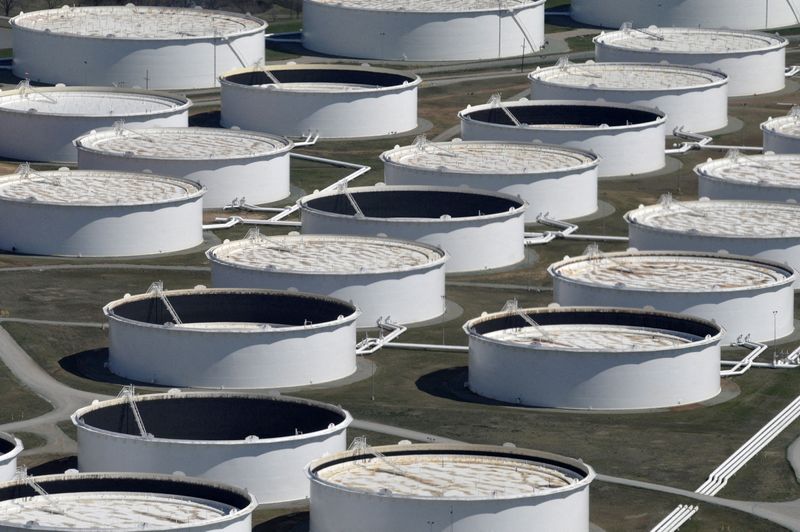Commodities
Oil spikes as Middle East strife heightens supply concerns


© Reuters. FILE PHOTO: Crude oil storage tanks are seen from above at the Cushing oil hub, appearing to run out of space to contain a historic supply glut that has hammered prices, in Cushing, Oklahoma, March 24, 2016. REUTERS/Nick Oxford//File Photo
By Natalie Grover
LONDON (Reuters) -Global oil benchmark Brent hit $93 a barrel on Wednesday as the risk of escalating conflict in the Middle East threatened to disrupt oil supplies from the region, with Iran calling for an oil embargo to be imposed on Israel.
Brent crude futures were up $1.33, or about 1.5%, to $91.23 a barrel at 1231 GMT. West Texas Intermediate crude (WTI) futures were up $1.28, or roughly 1.5%, at $87.94 a barrel.
Both benchmarks gained more than $3 to touch their highest levels in two weeks earlier in the session.
Markets factored in risk premiums after hundreds of Palestinians were killed in a blast at a Gaza City hospital on Tuesday that Israeli and Palestinian officials blamed on each other.
Jordan then cancelled a summit it was to host with U.S. President Joe Biden and Egyptian and Palestinian leaders. Biden arrived in Israel on Wednesday pledging solidarity in its war against Hamas, and backing its account that the Gaza hospital blast had been caused by militants.
“This turn of diplomatic fortunes again garners fear of conflict spread and therefore the leap in oil,” said John Evans of oil broker PVM.
Elsewhere in the Saudi city of Jeddah, Iranian Foreign Minister Hossein Amirabdollahian urged members of the Organisation of Islamic Cooperation to impose an oil embargo on Israel.
OPEC+ is not planning to take any immediate action on Iran’s call, two sources from the producer group told Reuters.
“A long occupation looms as the scenario that pushes above $US100/bbl because it raises the risk that the Israel Hamas conflict expands and potentially draws in Iran directly,” added Vivek Dhar, an analyst at Commonwealth Bank of Australia (OTC:).
Geopolitical tensions aside, other drivers are also supporting oil prices.
stocks fell by a much-steeper-than-expected 4.4 million barrels in the week ended Oct. 13, compared to the forecast of a 300,000 barrel fall, according to market sources citing American Petroleum Institute figures on Tuesday. [API/S]
Official U.S. government data is due later on Wednesday.
On the demand side, China’s economy grew faster-than- expected in the third quarter, official data on Wednesday showed, suggesting a recent flurry of policy measures is helping to bolster a tentative recovery.
Data also showed that the country’s oil refinery throughput in September hit a record daily rate, up 12% from a year earlier, as refiners increased run rates to cater for strong demand for transport fuel over the Golden Week holiday and improving manufacturing activity.
But analysts sounded caution on China’s economy, with the country’s real estate sector still in peril.
“The economic recovery is still in its infancy,” Moody’s (NYSE:) Analytics economist Harry Murphy Cruise said.
Meanwhile, higher-than-expected September U.S. retail sales spurred expectations of another interest rate hike by year-end. Interest rate hikes to curb inflation can slow economic growth and reduce oil demand.
Commodities
Oil prices rise; U.S. crude inventories plunge, Russia-Ukraine truce eyed
Commodities
India’s Reliance to stop buying Venezuelan oil over US tariffs, sources say
Commodities
Oil prices climb on Venezuela supply worries

 Forex3 years ago
Forex3 years agoForex Today: the dollar is gaining strength amid gloomy sentiment at the start of the Fed’s week

 Forex3 years ago
Forex3 years agoUnbiased review of Pocket Option broker

 Forex3 years ago
Forex3 years agoDollar to pound sterling exchange rate today: Pound plummeted to its lowest since 1985

 Forex3 years ago
Forex3 years agoHow is the Australian dollar doing today?

 Cryptocurrency3 years ago
Cryptocurrency3 years agoWhat happened in the crypto market – current events today

 World3 years ago
World3 years agoWhy are modern video games an art form?

 Commodities3 years ago
Commodities3 years agoCopper continues to fall in price on expectations of lower demand in China

 Economy3 years ago
Economy3 years agoCrude oil tankers double in price due to EU anti-Russian sanctions

































